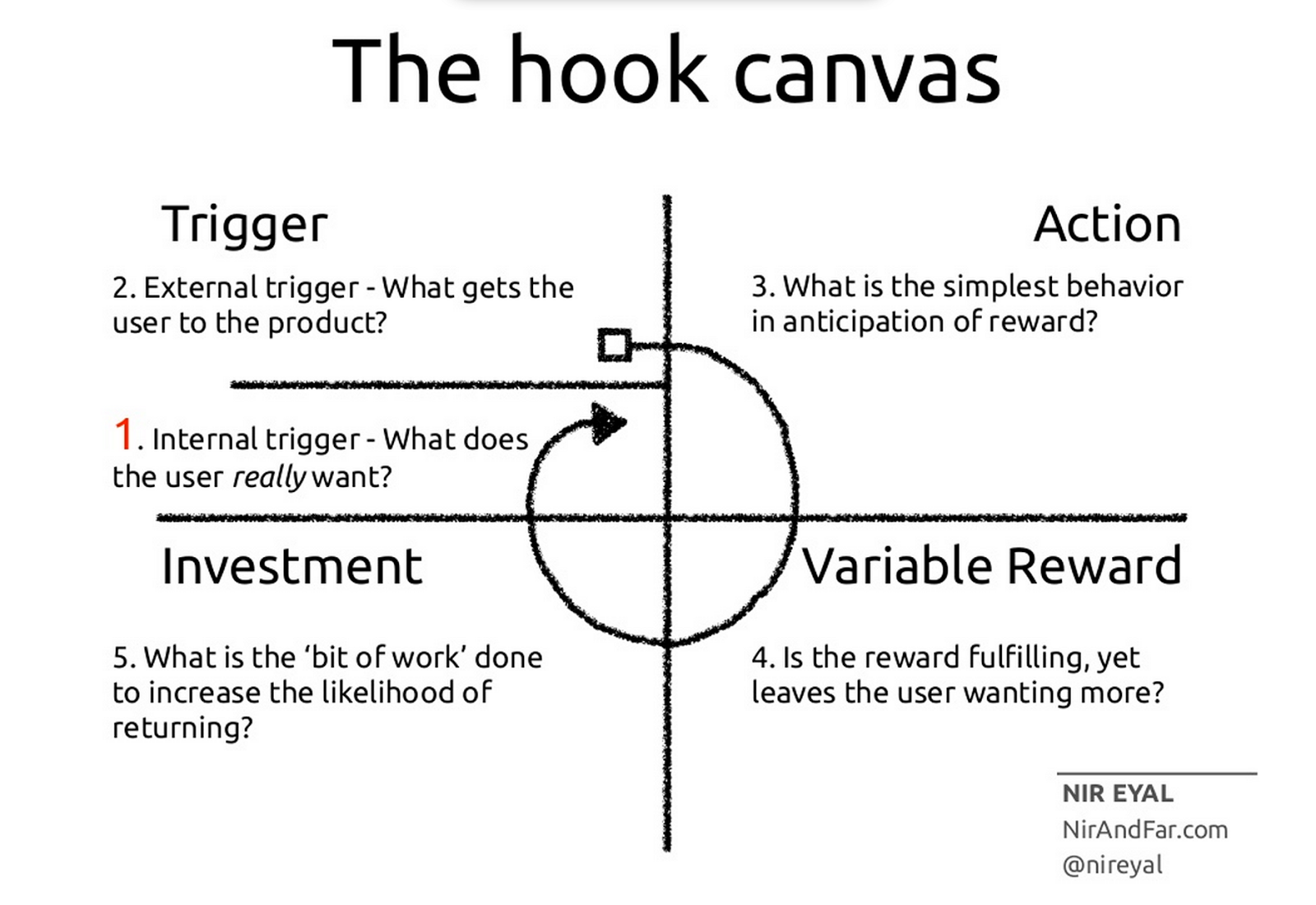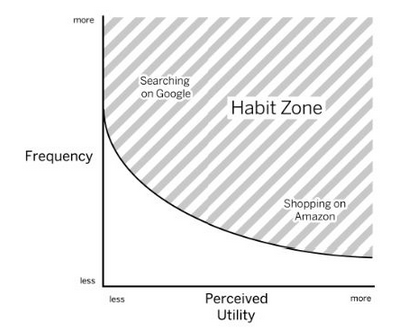🪝 Nir Eyal - Hooked
Trigger
- An e-mail, a link, an icon on your phone
- Can be external or internal
Action
- The behavior done in anticipation of a reward
Variable reward
- Predictability doesn't create a desire
- Suppose a different treat magically appears in your fridge every time you open it and voila intrigue is created
- High variability improves retention and increases engagement
Investment
- Investment increases the odds that the user will make another pass through the cycle
- User puts in time, data, effort, social capital, or money
- User invites friends, states preferences, collect virtual items, learns to use new features, etc
- It's an action to improve the service for the next go-around
What are habits?
- How our brains learn complex behaviors
- The give us the ability to focus attention on other things by storing automatic responses in the basal ganglia, an area of the brain associated with involuntary actions
- Habits form when the brain takes a shortcut and stops actively deliverating over what to do next. Example: nail biting stars deliberately to remove an annoying fingernail but over time becomes automatically triggered by stress
💡 When a behavior happens as an automatic response to a cue - the habit is in control.
It takes work to adjust an established habit. For instance, if you usually run in the morning, when running in the evening you might say “good morning” to anyone you see as that's been a good decision that became a habit.
💡 Once we make a good decision, our brain tends to automate it into a habit.
1. The Habit Zone
- Engaged users increase CLV
- Engaged users create more viral loops (think tagging people on FB)
- Engaged users build a habit and are less sensitive to price changes
- User habits are a competitive advantage → sticky users that won't switch to competitors.
Many innovations fail because consumers irrationally overvalue the old while companies irrationally overvalue the new.
- John Gourville
QWERTY was developed in 1870s for old typewritters and is still dominant today despite other (probably better) designs.
💡 Old habits die hard. Dramatic improvements are needed to share users out of old routines.
The non-transferable value that users create inside your products discourages them from leaving. Conversations in gmail, followers on Twitter, etc.
The habits you've most recently acquired are also the ones most likely to go soonest.
💡 Habits are LIFO.
For new behaviors to really take hold, they must occur often. Utility on its own with low frequency of use will never create a habit.
Painkillers vs vitamins
- Painkillers solve an obvious need, relieving a specific pain. It's immediately useful and measurably effective.
- Viramins appeal to user's emotional rather than functional needs. We want to do something “good” even if we can't perceive how good it is.
A habit is when not doing an action causes a bit of discomfort.
2. Trigger
Triggers provide the basis for sustained behavior change. They are actuators of behavior and are the fundamental requirement for building a habit.
They can create users for you when placed in a user's environment or engage existing users through associations stored in the user's memory.
💡 When designing triggers, make it easy on the user. Reducing the thinking require to take the next action increases the likelihood of the desired behavior occuring with little thought.
Acquisition triggers
Another example of a trigger would be a paid trigger, i.e. SEO, marketing, ads. These are usually used to acquire new users while other triggers help with bringing them back (i.e. re-engaging existing users).
These kinds of marketing triggers can also be earned instead of paid for. Think favorable press mentions, hot viral videos, or featured app store placements. The flip side to these is that they're hard to leverage consistently (as they're not entirely in our power).
Relationship triggers like product referrals from friends can create a viral growth loops.
Engagement triggers
Externally to a product, triggers can consume real estate in user's environment. For example an app icon on a user's phone, an email newsletter they subscribed to, or an app update notification that appears if a user wants it there. The important aspect of these triggers is that they require user's concent.
Internally to a product, when you couple a trigger with a thought, emotion or a preexisting routing, you can generate a habit with enough repetition.
Feelings of boredom, loneliness, frustration, confusion, and indecisiveness often instigate a slight pain or irritation and prompt an almost instantaneous and often mindless action to quell the negative sensation. The severity of the discomfot is minor and below the immediate perceptibility of consciousness, which helps make it a subconscious reaction.
💡 By attaching your product as a solution to a negative feeling, one that creates relief, you can cement a habitual bond with the user.
Example.: We use email or slack to validate our importance by checking if someone needs us.
Example: Posting on Instagram because of fear of forever losing a special moment. Anytime you experience a special moment you feel the urge of posting it on Instagram. Instagram also helps alleviate boredom by always offering a solution for it.
💡 Solve a user's pain by creating an association so that the user identifies your product as the source of relief.
You'll often find that people's declared preferences - what they say they want - are far different from their revealed preferences - what they actually do. Looking for these discrepancies exposes opportunities.
See also: Behavioral Design
When designing a product or a part of it, start with a user narative. Tell a story of the users journey to and through your product. Pain the picture of a pain or discomfort that is solved by using your product. What are the user's desires, emotions, the context within they use the product?
https://www.youtube.com/watch?v=acMXhhdWylQ
5-Whys: Try asking “Why?” about your users behavior until you get to the emotion.
© nem035RSS
